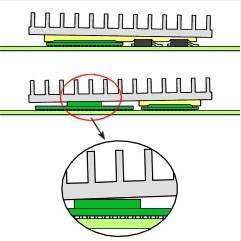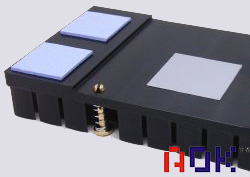Multiple heat sources with a single heat sink
More and more designer cooling multiple heat sources with a single heat sink, but it can create critical design issues, and it may not be recommended. However, there are cases where this design approach is advantageous, so the following design considerations should be taken into account.

The most significant design consideration when cooling multiple heat sources with a single heat sink is dealing with the stack up heights and tolerances of the different devices.
A picture of example heat sink
For example, assume the cooling of two identical devices with one heat sink:
If the height tolerance is 0.1mm, the worst case height difference would be 0.2mm. The heat sink may contact one chip, but not the other. Or, the heat sink may contact both chips, but in a tilted orientation. In either case, poor contact would be the result, creating a serious thermal issue.
The approach is to use a thick and compliant gap pad as the thermal interface material(such as thermal pad or other thermal materials). Because thermal pad can be cuted in any size and any thickness, so this material will fill any gaps and ensure that contact is made between the heat sink and all devices. However, thermal pads offer inferior thermal performance compared to grease or phase change material. If one of the heat sources is a critical component dissipating high thermal loads, this approach can severely impact the performance and reliability of the device. so there should be a high thermal conduction interface materials filled it.
A picture of example thermal pad used with a heat sink

In this case, a relatively high attachment force is required to ensure that the gap pad material is sufficiently compressed to allow the heat sink to make contact with each device. All of our standard mounting options can be used in cooling multiple heat sources with a single heat sink.

